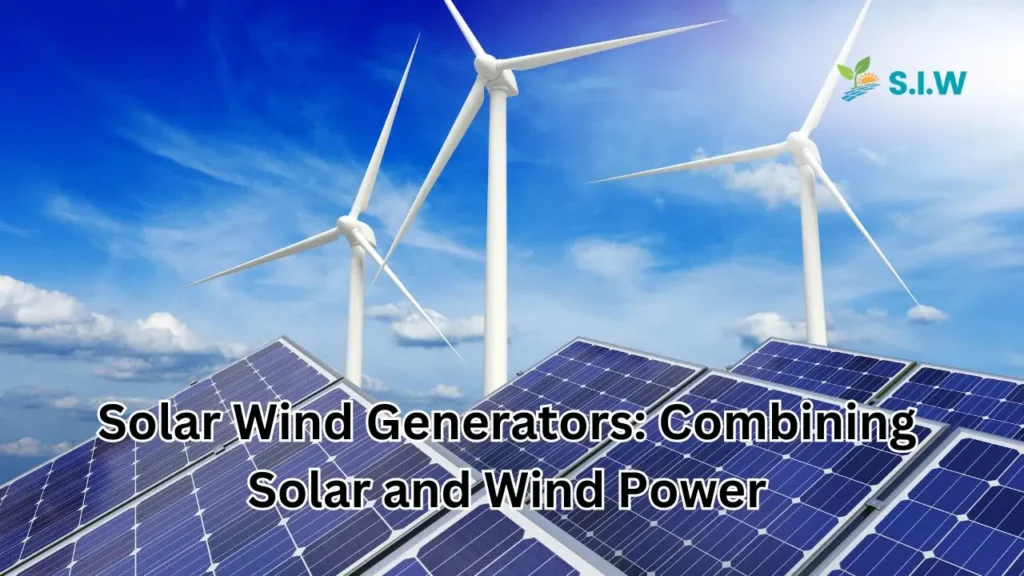Have you ever wished for a power source that could harness both the sun and the wind? Solar wind generators are like the ultimate hybrid vehicle, but for energy. They combine solar panels and wind turbines into a single unit, providing a steady flow of electricity regardless of whether it’s sunny or breezy.
What is a Solar Wind Generator?
A solar wind generator is a renewable energy system that integrates solar panels and wind turbines. This combination allows the system to capture energy from both solar and wind sources. Think of it like a chef combining ingredients to create a dish that’s richer and more satisfying than any single ingredient on its own.
How Do Solar Wind Generators Work?
These systems work by using both wind turbines and solar panels to generate electricity. The wind turbines capture wind energy, while the solar panels capture sunlight. This dual approach maximizes energy production because it’s rare for both sources to be completely unavailable at the same time. For instance, even if it’s cloudy, wind might still be blowing, and vice versa.
Advantages of Combining Solar and Wind Power
Combining solar and wind power has several benefits:
- Reliability: By tapping into two sources of energy, solar wind generators provide a more stable power supply.
- Increased Efficiency: They can generate electricity even when one of the sources is not available.
- Reduced Energy Costs: Over time, the efficiency of these systems can lead to minimize energy bills.
Components of a Solar Wind Generator
A solar wind generator typically includes:
- Solar Panels: These capture sunlight and convert it into electricity.
- Wind Turbines: These harness wind energy to generate power.
- Inverter: This converts the direct current (DC) from the solar panels and wind turbines into alternating current (AC) for home use.
- Battery Storage: This stores excess energy for use when solar or wind resources are low.
Installation Process
Installing a solar wind generator involves several steps:
- Site Assessment: Evaluating the location for solar exposure and wind conditions.
- Permits and Regulations: Obtaining necessary permits and ensuring compliance with local regulations.
- System Setup: Installing the solar panels, wind turbines, and other components.
- Connection: Hooking up the system to the grid or a battery storage system.
Cost Considerations
The initial cost of installing a solar wind generator can be higher than traditional solar or wind systems. However, the combined energy production can lead to cost savings over time. Factors influencing the cost include:
- Size of the System: Larger systems generally cost more.
- Location: Installation costs can vary based on location and accessibility.
- Maintenance: Regular maintenance is necessary to keep the system running efficiently.
Maintenance and Durability
Maintaining a solar wind generator involves:
- Regular Inspections: Checking for wear and tear on both the solar panels and wind turbines.
- Cleaning: Keeping the panels and turbines clean to ensure optimal performance.
- Repairs: Addressing any issues that arise promptly to prevent further damage.
Environmental Impact
Solar wind generators have a positive environmental impact:
- Reduced Carbon Footprint: They generate clean, renewable energy without emitting greenhouse gases.
- Less Resource Intensive: They rely on natural resources rather than finite fossil fuels.
Comparing Solar Wind Generators with Traditional Systems
When comparing solar wind generators to traditional solar or wind systems:
- Energy Production: Hybrid systems often provide more consistent energy production.
- Cost: Initial costs might be higher, but long-term savings can be greater.
- Complexity: Hybrid systems are more complex but offer the benefits of dual energy sources.
Future of Solar Wind Generators
The future looks bright for solar wind generators. Advances in technology are making them more efficient and affordable. Innovations in materials and design are expected to enhance performance and reduce costs further.
Case Studies and Real-World Applications
Several projects around the world demonstrate the effectiveness of solar wind generators:
- Residential Installations: Homeowners are using them to reduce energy bills and increase self-sufficiency.
- Remote Locations: They are providing power to areas that are off the grid or have unreliable energy sources.
Common Myths and Misconceptions
Some common myths about solar wind generators include:
- “They don’t work well together.” In reality, combining solar and wind energy can be very effective.
- “They are too expensive.” While the initial cost is higher, the long-term savings often outweigh the upfront investment.
How to Choose the Right Solar Wind Generator for Your Needs
When selecting a solar wind generator, consider:
- Energy Needs: Assess your energy requirements to choose the appropriate system size.
- Local Conditions: Ensure the system is suitable for your area’s solar and wind conditions.
- Budget: Factor in both initial costs and potential savings over time.
Conclusion and Summary
Solar wind generators represent a promising fusion of solar and wind power, offering a reliable and efficient way to harness renewable energy. By integrating these two technologies, they provide a steady supply of electricity and contribute to a more sustainable future. If you’re considering investing in renewable energy, a solar wind generator might be the perfect solution for maximizing your energy production and minimizing your environmental impact.
FAQs
- What are solar wind generators?
Solar wind generators combine solar panels and wind turbines to generate electricity from both solar and wind energy sources. - How do solar wind generators work?
They use solar panels to capture sunlight and wind turbines to harness wind energy, providing a more consistent power supply. - What are the benefits of using a solar wind generator?
The main benefits include increased reliability, higher efficiency, and potential cost savings over time. - How much does it cost to install a solar wind generator?
Installation costs vary based on system size, location, and other factors, but they are generally higher than traditional solar or wind systems. - How do solar wind generators compare to traditional solar or wind systems?
Hybrid systems often provide more consistent energy production but may have higher initial costs and complexity.








